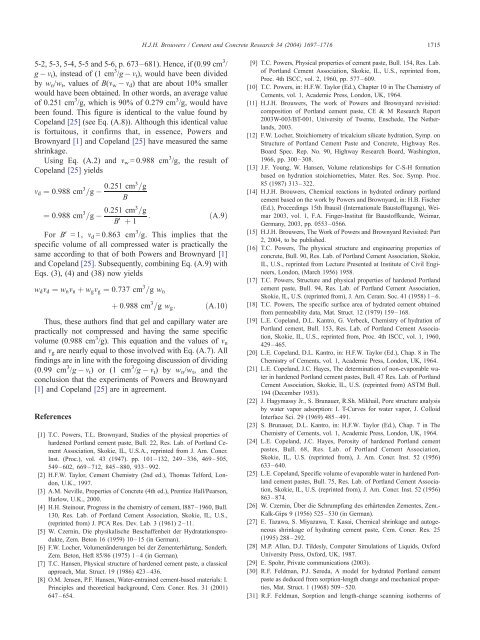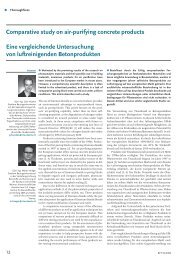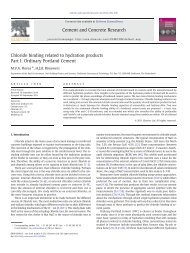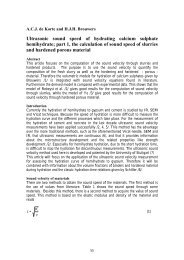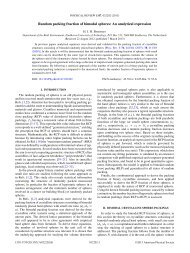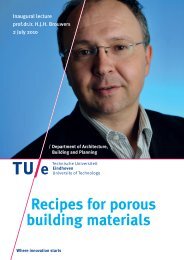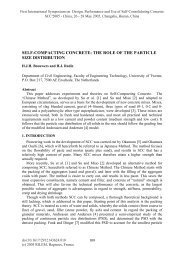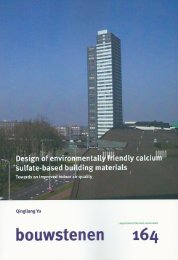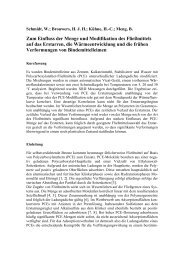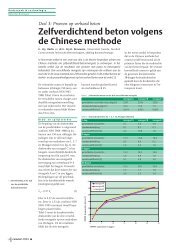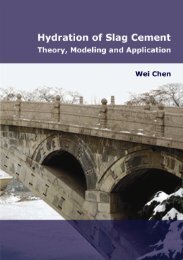The work of Powers and Brownyard revisited: Part 1 - Jos Brouwers
The work of Powers and Brownyard revisited: Part 1 - Jos Brouwers
The work of Powers and Brownyard revisited: Part 1 - Jos Brouwers
Create successful ePaper yourself
Turn your PDF publications into a flip-book with our unique Google optimized e-Paper software.
H.J.H. <strong>Brouwers</strong> / Cement <strong>and</strong> Concrete Research 34 (2004) 1697–1716 17155-2, 5-3, 5-4, 5-5 <strong>and</strong> 5-6, p. 673–681). Hence, if (0.99 cm 3 /g m t ), instead <strong>of</strong> (1 cm 3 /g m t ), would have been dividedby w n /w t , values <strong>of</strong> B(m w m d ) that are about 10% smallerwould have been obtained. In other words, an average value<strong>of</strong> 0.251 cm 3 /g, which is 90% <strong>of</strong> 0.279 cm 3 /g, would havebeen found. This figure is identical to the value found byCopel<strong>and</strong> [25] (see Eq. (A.8)). Although this identical valueis fortuitous, it confirms that, in essence, <strong>Powers</strong> <strong>and</strong><strong>Brownyard</strong> [1] <strong>and</strong> Copel<strong>and</strong> [25] have measured the sameshrinkage.Using Eq. (A.2) <strong>and</strong> m w = 0.988 cm 3 /g, the result <strong>of</strong>Copel<strong>and</strong> [25] yieldsm d ¼ 0:988 cm 3 =g0:251 cm 3 =gB¼ 0:988 cm 3 0:251 cm 3 =g=g: ðA:9ÞBV þ 1For BV =1, m d = 0.863 cm 3 /g. This implies that thespecific volume <strong>of</strong> all compressed water is practically thesame according to that <strong>of</strong> both <strong>Powers</strong> <strong>and</strong> <strong>Brownyard</strong> [1]<strong>and</strong> Copel<strong>and</strong> [25]. Subsequently, combining Eq. (A.9) withEqs. (3), (4) <strong>and</strong> (38) now yieldsw d m d ¼ w n m n þ w g m g ¼ 0:737 cm 3 =g w nþ 0:988 cm 3 =g w g :ðA:10ÞThus, these authors find that gel <strong>and</strong> capillary water arepractically not compressed <strong>and</strong> having the same specificvolume (0.988 cm 3 /g). This equation <strong>and</strong> the values <strong>of</strong> m n<strong>and</strong> m g are nearly equal to those involved with Eq. (A.7). Allfindings are in line with the foregoing discussion <strong>of</strong> dividing(0.99 cm 3 /g m t ) or (1 cm 3 /g m t ) by w n /w t , <strong>and</strong> theconclusion that the experiments <strong>of</strong> <strong>Powers</strong> <strong>and</strong> <strong>Brownyard</strong>[1] <strong>and</strong> Copel<strong>and</strong> [25] are in agreement.References[1] T.C. <strong>Powers</strong>, T.L. <strong>Brownyard</strong>, Studies <strong>of</strong> the physical properties <strong>of</strong>hardened Portl<strong>and</strong> cement paste, Bull. 22, Res. Lab. <strong>of</strong> Portl<strong>and</strong> CementAssociation, Skokie, IL, U.S.A., reprinted from J. Am. Concr.Inst. (Proc.), vol. 43 (1947). pp. 101–132, 249–336, 469–505,549–602, 669–712, 845–880, 933–992.[2] H.F.W. Taylor, Cement Chemistry (2nd ed.), Thomas Telford, London,U.K., 1997.[3] A.M. Neville, Properties <strong>of</strong> Concrete (4th ed.), Prentice Hall/Pearson,Harlow, U.K., 2000.[4] H.H. Steinour, Progress in the chemistry <strong>of</strong> cement, l887–1960, Bull.130, Res. Lab. <strong>of</strong> Portl<strong>and</strong> Cement Association, Skokie, IL, U.S.,(reprinted from) J. PCA Res. Dev. Lab. 3 (1961) 2–11.[5] W. Czernin, Die physikalische Beschaffenheit der Hydratationsprodukte,Zem. Beton 16 (1959) 10–15 (in German).[6] F.W. Locher, Volumenänderungen bei der Zementerhärtung, Sonderh.Zem. Beton, Heft 85/86 (1975) 1 –4 (in German).[7] T.C. Hansen, Physical structure <strong>of</strong> hardened cement paste, a classicalapproach, Mat. Struct. 19 (1986) 423–436.[8] O.M. Jensen, P.F. Hansen, Water-entrained cement-based materials: I.Principles <strong>and</strong> theoretical background, Cem. Concr. Res. 31 (2001)647–654.[9] T.C. <strong>Powers</strong>, Physical properties <strong>of</strong> cement paste, Bull. 154, Res. Lab.<strong>of</strong> Portl<strong>and</strong> Cement Association, Skokie, IL, U.S., reprinted from,Proc. 4th ISCC, vol. 2, 1960, pp. 577–609.[10] T.C. <strong>Powers</strong>, in: H.F.W. Taylor (Ed.), Chapter 10 in <strong>The</strong> Chemistry <strong>of</strong>Cements, vol. 1, Academic Press, London, UK, 1964.[11] H.J.H. <strong>Brouwers</strong>, <strong>The</strong> <strong>work</strong> <strong>of</strong> <strong>Powers</strong> <strong>and</strong> <strong>Brownyard</strong> <strong>revisited</strong>:composition <strong>of</strong> Portl<strong>and</strong> cement paste, CE & M Research Report2003W-003/BT-001, University <strong>of</strong> Twente, Enschede, <strong>The</strong> Netherl<strong>and</strong>s,2003.[12] F.W. Locher, Stoichiometry <strong>of</strong> tricalcium silicate hydration, Symp. onStructure <strong>of</strong> Portl<strong>and</strong> Cement Paste <strong>and</strong> Concrete, Highway Res.Board Spec. Rep. No. 90, Highway Research Board, Washington,1966, pp. 300–308.[13] J.F. Young, W. Hansen, Volume relationships for C-S-H formationbased on hydration stoichiometries, Mater. Res. Soc. Symp. Proc.85 (1987) 313–322.[14] H.J.H. <strong>Brouwers</strong>, Chemical reactions in hydrated ordinary portl<strong>and</strong>cement based on the <strong>work</strong> by <strong>Powers</strong> <strong>and</strong> <strong>Brownyard</strong>, in: H.B. Fischer(Ed.), Proceedings 15th Ibausil (Internationale Baust<strong>of</strong>ftagung), Weimar2003, vol. 1, F.A. Finger-Institut für Baust<strong>of</strong>fkunde, Weimar,Germany, 2003, pp. 0553–0566.[15] H.J.H. <strong>Brouwers</strong>, <strong>The</strong> Work <strong>of</strong> <strong>Powers</strong> <strong>and</strong> <strong>Brownyard</strong> Revisited: <strong>Part</strong>2, 2004, to be published.[16] T.C. <strong>Powers</strong>, <strong>The</strong> physical structure <strong>and</strong> engineering properties <strong>of</strong>concrete, Bull. 90, Res. Lab. <strong>of</strong> Portl<strong>and</strong> Cement Association, Skokie,IL, U.S., reprinted from Lecture Presented at Institute <strong>of</strong> Civil Engineers,London, (March 1956) 1958.[17] T.C. <strong>Powers</strong>, Structure <strong>and</strong> physical properties <strong>of</strong> hardened Portl<strong>and</strong>cement paste, Bull. 94, Res. Lab. <strong>of</strong> Portl<strong>and</strong> Cement Association,Skokie, IL, U.S. (reprinted from), J. Am. Ceram. Soc. 41 (1958) 1 – 6.[18] T.C. <strong>Powers</strong>, <strong>The</strong> specific surface area <strong>of</strong> hydrated cement obtainedfrom permeability data, Mat. Struct. 12 (1979) 159–168.[19] L.E. Copel<strong>and</strong>, D.L. Kantro, G. Verbeck, Chemistry <strong>of</strong> hydration <strong>of</strong>Portl<strong>and</strong> cement, Bull. 153, Res. Lab. <strong>of</strong> Portl<strong>and</strong> Cement Association,Skokie, IL, U.S., reprinted from, Proc. 4th ISCC, vol. 1, 1960,429–465.[20] L.E. Copel<strong>and</strong>, D.L. Kantro, in: H.F.W. Taylor (Ed.), Chap. 8 in <strong>The</strong>Chemistry <strong>of</strong> Cements, vol. 1, Academic Press, London, UK, 1964.[21] L.E. Copel<strong>and</strong>, J.C. Hayes, <strong>The</strong> determination <strong>of</strong> non-evaporable waterin hardened Portl<strong>and</strong> cement pastes, Bull. 47 Res. Lab. <strong>of</strong> Portl<strong>and</strong>Cement Association, Skokie, IL, U.S. (reprinted from) ASTM Bull.194 (December 1953).[22] J. Hagymassy Jr., S. Brunauer, R.Sh. Mikhail, Pore structure analysisby water vapor adsorption: I. T-Curves for water vapor, J. ColloidInterface Sci. 29 (1969) 485–491.[23] S. Brunauer, D.L. Kantro, in: H.F.W. Taylor (Ed.), Chap. 7 in <strong>The</strong>Chemistry <strong>of</strong> Cements, vol. 1, Academic Press, London, UK, 1964.[24] L.E. Copel<strong>and</strong>, J.C. Hayes, Porosity <strong>of</strong> hardened Portl<strong>and</strong> cementpastes, Bull. 68, Res. Lab. <strong>of</strong> Portl<strong>and</strong> Cement Association,Skokie, IL, U.S. (reprinted from), J. Am. Concr. Inst. 52 (1956)633–640.[25] L.E. Copel<strong>and</strong>, Specific volume <strong>of</strong> evaporable water in hardened Portl<strong>and</strong>cement pastes, Bull. 75, Res. Lab. <strong>of</strong> Portl<strong>and</strong> Cement Association,Skokie, IL, U.S. (reprinted from), J. Am. Concr. Inst. 52 (1956)863–874.[26] W. Czernin, Über die Schrumpfung des erhärtenden Zementes, Zem.-Kalk-Gips 9 (1956) 525–530 (in German).[27] E. Tazawa, S. Miyazawa, T. Kasai, Chemical shrinkage <strong>and</strong> autogeneousshrinkage <strong>of</strong> hydrating cement paste, Cem. Concr. Res. 25(1995) 288–292.[28] M.P. Allan, D.J. Tildesly, Computer Simulations <strong>of</strong> Liquids, OxfordUniversity Press, Oxford, UK, 1987.[29] E. Spohr, Private communications (2003).[30] R.F. Feldman, P.J. Sereda, A model for hydrated Portl<strong>and</strong> cementpaste as deduced from sorption-length change <strong>and</strong> mechanical properties,Mat. Struct. 1 (1968) 509–520.[31] R.F. Feldman, Sorption <strong>and</strong> length-change scanning isotherms <strong>of</strong>


